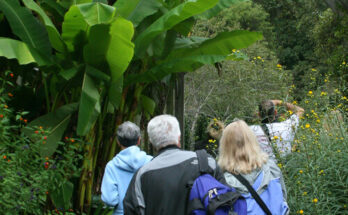Even though we like to think much in our lives is predictable and at least somewhat under our control, everything is continually changing, and the garden is a perfect teacher of how all life must continually adapt in order to thrive. We are currently experiencing a period of global changes that are creating a perfect storm in almost every aspect of life. In nature there is little “right” or “wrong,” just what works and what doesn’t.
In the garden, some plants are adapting to environmental changes better than others. Maybe we should reexamine what is working in our landscapes and what we’re conditioned to believe is “beautiful.” Here are some lovely and interesting native plants that not only have a lot to offer for a new landscaping aesthetic but also are primed to survive best in gardens where high-maintenance, expiring lawns and plantings are failing us.
These five plants are examples of beauty that evolved naturally in the dry, hungry soils and hot sun of Southern California. All do well in our Zones 9–11 gardens, and they boast outstanding attributes that make them worthy conversation pieces.

Wooly blue curls is a standout with purple blooms in late winter
Wooly blue curls (Trichostema lanatum, Zones 8–10) is a native shrub of the canyons that is as colorful and unique as any fancy hybrid available. This showy local native plant sports fascinating, fuzzy, rich blue and purple flowers in late winter or early spring. It is a woody shrub with sparse, rosemary-like leaves that offer an herbal scent. Grow it where an informal, upright splash of color (roughly up to 6 feet tall and 5 feet wide) will fit into your design. Wooly blue curls thrives in the heat and full sun. A nectar plant for our local bees, butterflies, and hummingbirds, it needs no water at all in the summertime.

Chocolate daisy smells like a delicious treat and is great for rocky crevices
Chocolate daisy (Berlandiera lyrata and cvs., Zones 4–10) is a pretty, well-behaved perennial that produces daisy-like flowers that really smell just like chocolate. Although this plant didn’t evolve in Southern California, it is native to Southwest deserts and makes a fine conversation piece for inland SoCal gardens. Study the blooms of the chocolate daisy closely to appreciate the rust-striped petal backs and the decorative red, yellow, and green centers. Flowers go from late spring into fall and are most strongly scented in mornings and evenings. This little perennial will grow about 18 inches tall and about 12 inches wide before arching over, making it a perfect partner for softening rocky areas or filling holes and crevices in full sun. It may even self-seed in your garden if it is happy enough.

Chalk lettuce has a bold rosette form with fun powdery leaves
Chalk lettuce (Dudleya pulverulenta, Zones 8–10) is a big, baby blue–tinted, flower-shaped succulent covered with a fine dusting of white powder. It’s irresistible to children for face painting. Happily perched on hillsides as well as nestled among rocks, this bold sculptural rosette will grow 1 to 2 feet tall and wide, claiming its place as a living sculpture. It even displays long, graceful, wiry arches of pink flowers in late spring and early summer that may politely seed about. Accepting dry conditions, chalk lettuce handles occasional downpours in soil with good drainage. Plants that offer this much beauty and fun in our dry, hot summer sun are exactly what we need in our gardens to make them exciting again.

Milkweeds are the ultimate native plants for monarch butterflies
Milkweeds (Asclepias spp. and cvs., Zones 3–11) are ornamental perennials famous for colorful summer flowers, silken parachutes of floating seeds, and supporting the miraculous life cycle of the monarch butterfly. Although there are other milkweed varieties native to North America, varieties that are native to SoCal, such as lavender-pink California milkweed (Asclepias californica, Zones 7–10) and white-flowering narrow-leaved milkweed (Asclepias fascicularis, Zones 6–10), are the most likely to help our local monarch butterflies survive best. These butterflies are now on the official endangered species list, and they rely not only on nectar and food plants but on milkweeds that supply the safe microorganisms found only in local environments where their species developed. Milkweeds typically grow 3 to 5 feet tall and up to 2 feet wide. They thrive in full sun and well-drained soil.

Mariposa lilies deliver a wonderful assortment of late winter blooms
There are a large number of mariposa lilies (Calochortus spp. and cvs., Zones 5–10) that are indigenous to Southern California. These fragile-looking, tulip-like flowers grow from small bulbs that love the parched, hungry SoCal climate. Most bloom on graceful, thin stems and show off kaleidoscopic designs and patterns inside the delicate, colorful petals. All mariposa lilies have a thin, tall habit of growth but come in an assortment of colors and heights. If winter rainfall is stingy, give them a little extra water for an enchanting performance in late winter. Once they finish blooming, they need neither care nor water until the next winter season rolls around.
Beauty comes in many forms. Let’s expand the vision of beauty in our landscapes to include scent, sculptural form, texture, and motion. We can attract birds, bees, and butterflies while colorful flowers dance gracefully in tandem with increasing winds. In a world infected with so much stress, let’s use the native gifts of nature to help us and our gardens thrive in these changing times.
—Jane Gates has more than 35 years of professional experience designing and gardening in Los Angeles and is the author of All the Garden’s a Stage: Choosing the Best Performing Plants for a Sustainable Garden.
Source link
Originally posted 2022-11-08 19:47:33.




